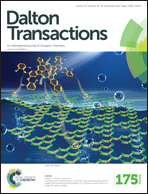Fabrication of RGD-conjugated Gd(OH)3:Eu nanorods with enhancement of magnetic resonance, luminescence imaging and in vivo tumor targeting†
Abstract
The development of multimodal probes with magnetic resonance imaging (MRI) and intraoperative fluorescence imaging is the most challenging task in the field of tumor diagnosis. Herein, a simple one-pot hydrothermal method is used to prepare Eu-doped Gd(OH)3 nanorods (Gd(OH)3:Eu NRs) with good fluorescence and the longitudinal relaxivity r1 value of 4.78 (Gd mM s−1). After dual-functionalized maleimide-polyethylene glycol-succinimide (Mal-PEG-NHS) macromolecules are coated on the surface of Gd(OH)3:Eu NRs (PEG-NRs), the results of a lower degradation ratio in newborn calf serum (NCS), reactive oxygen species (ROS) generation in L929 cells and the hemolytic rate of PEG-NRs show their good cyto-compatibility and longer blood circulation time. Moreover, the actively tumor-targeting properties are endowed to NRs through the conjugation of cyclic arginine-glycine-aspartic acid (cRGD) (denoted RGD-NRs). The bio-distributions of RGD-NRs in tumor-bearing nude mice via tail-vein injection indicate that RGD-NRs are specifically taken-up by gliomas. The tests of in vivo T1-weighted MR imaging via tail-vein injection confirm that RGD-NRs possess a higher positive signal-enhancement ability in gliomas. Besides, the better luminescence imaging of living cells under a fluorescence microscope and the clear in vivo fluorescence imaging further confirm the targeting properties and better in vivo optical imaging behavior of RGD-NRs.


 Please wait while we load your content...
Please wait while we load your content...